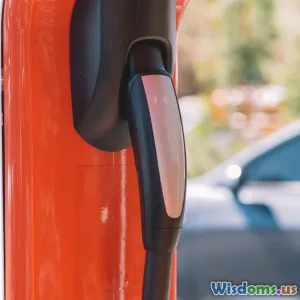
The Science Behind Regenerative Braking in Modern Electric Cars
8 min read Explore the science behind regenerative braking and how it transforms energy efficiency in modern electric vehicles. (0 Reviews)
The Science Behind Regenerative Braking in Modern Electric Cars
Electric vehicles (EVs) are reshaping the landscape of transportation, promising a cleaner, more sustainable future. Among the fascinating innovations that make these vehicles so efficient lies a technology quietly revolutionizing the way cars recapture energy: regenerative braking. You’ve likely heard the term before, but what exactly happens when your electric car slows down? This article dives deep into the science behind regenerative braking, revealing how it extends battery life, boosts range, and transforms kinetic energy back into usable power.
Understanding Braking: Conventional vs. Regenerative
Traditional braking systems in gasoline-powered cars primarily use friction brakes. When you press the brake pedal, pads clamp onto metal discs, converting kinetic energy—the vehicle’s momentum—into heat, which dissipates into the environment. This process wastes a significant amount of energy.
In contrast, regenerative braking leverages physics and electrical engineering to harvest energy that would otherwise be lost. This recovery takes advantage of the electric motor's ability to function as both a motor and a generator—a principle central to EV functionality.
How Regenerative Braking Works
The Electric Motor as a Generator
At the core of regenerative braking is the electric motor’s dual role. When accelerating, the motor consumes electrical energy from the battery to spin the wheels. When braking, it reverses this operation: the wheels drive the motor, which generates electricity.
This switch turns the motor into a generator that resists wheel rotation. The kinetic energy from the vehicle’s motion is converted into electrical energy and fed back into the battery pack, effectively “recharging” it.
Energy Flow Dynamics
The energy flow during regenerative braking involves precise electronic controls. Sensors detect the driver’s braking input and vehicle speed, modulating the motor’s response to optimize energy recuperation without compromising braking performance.
Modern EVs integrate advanced power electronics and software algorithms to blend regenerative braking with traditional friction brakes smoothly, ensuring safety and ride comfort.
The Physics Behind It
From a physics standpoint, regenerative braking is an elegant demonstration of energy conservation. Kinetic energy (KE) is given by the equation KE = 1/2 mv² (where m is mass and v is velocity). When a vehicle decelerates, the change in kinetic energy converts into other forms. In conventional braking, this energy turns to heat; regenerative braking converts it into electrical energy.
The effectiveness depends on factors like vehicle speed, weight, and battery charge state. Typically, regenerative braking recovers between 10% and 30% of the energy used during acceleration.
Real-World Impact: Efficiency and Range
Extending Electric Vehicle Range
One of the core advantages of regenerative braking is range extension. Since electric cars rely on limited battery capacity, reclaiming energy during braking is crucial. According to the US Department of Energy, regenerative braking can improve an EV’s energy efficiency by roughly 10-25% — a significant gain in daily driving.
Reducing Brake Wear
Besides enhancing efficiency, regenerative braking reduces wear on mechanical brake components. Since the electric motor provides much of the deceleration force, friction brakes are engaged less frequently. This reduction means less maintenance and lower long-term costs for EV owners.
Case Studies: Industry Leaders Harnessing Regenerative Braking
Tesla’s Regen System
Tesla vehicles feature an advanced regenerative braking system that can recover substantial energy during deceleration. Drivers notice “one-pedal driving,” where lifting off the accelerator slows the car significantly thanks to regeneration. Tesla’s software dynamically adjusts regen strength for safety and driving feel.
Toyota Prius: Pioneering Hybrids
Though not fully electric, Toyota’s Prius hybrid utilizes regenerative braking effectively. It captures energy during braking to charge its hybrid battery, allowing the gasoline engine to be downsized, cutting emissions and enhancing fuel economy.
Challenges and Limitations
While regenerative braking is revolutionary, it has limitations:
- Battery State of Charge (SoC): When a battery is near full, regeneration is limited since the battery can’t accept more energy.
- Low-Speed Efficiency: Regeneration is less effective at very low speeds where friction brakes are needed.
- Complexity: Integrating regenerative braking with traditional brake systems adds engineering complexity.
EV manufacturers continue to innovate, improving battery management and control systems to maximize regen effectiveness.
Future Directions: Smarter, More Efficient Systems
Emerging research is focused on enhancing regenerative systems through:
- Ultracapacitors: Pairing batteries with ultracapacitors can capture and deliver rapid energy bursts more efficiently.
- Vehicle-to-Everything (V2X): Regenerated energy might be shared back to grids in smart energy ecosystems.
- Improved Control Algorithms: Machine learning is helping optimize regeneration parameters based on driver habits and road conditions.
Conclusion: Regenerative Braking as a Cornerstone of Sustainable Mobility
Regenerative braking exemplifies how electric vehicles leverage sophisticated technology to redefine energy use. By converting lost kinetic energy into valuable electrical power, EVs extend driving range, reduce environmental impact, and lower operational costs. As the automotive industry pivots toward electrification, understanding the science behind regenerative braking not only enlightens consumers but also underscores the incredible engineering shaping our sustainable transportation future.
Next time you drive or ride in an electric car and glide to a stop, remember: you're witnessing a remarkable energy-saving dance, where science turns motion back into power.
References
- U.S. Department of Energy, Office of Energy Efficiency & Renewable Energy – Electric Vehicle Technologies.
- Tesla, Inc. – Tesla Model 3 Owner’s Manual; regenerative braking section.
- Toyota Motor Corporation – Prius Technology Handbook.
- IEEE Transactions on Vehicular Technology, Studies on Regenerative Braking Systems.
Rate the Post
User Reviews
Popular Posts



















